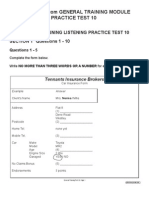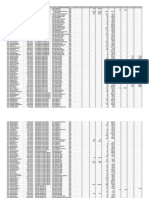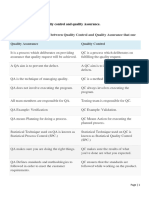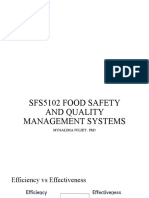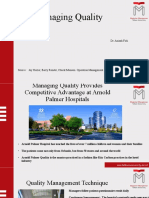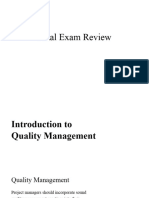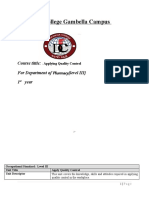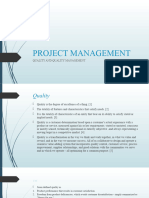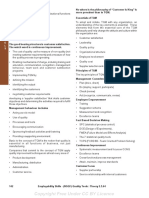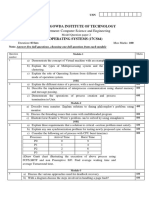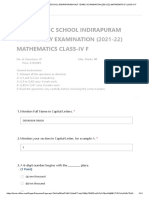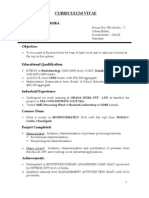0 ratings0% found this document useful (0 votes)
14 viewsEmployability Skills 2nd Sem Final-159
Employability Skills 2nd Sem Final-159
Uploaded by
SAVITA MAURYAThe document discusses key quality management terms like quality control, quality assurance, quality improvement, effectiveness, process, product, organization, customer, supplier, traceability, non-conformity, corrective action, preventive action, verification, and validation. It also outlines the importance and benefits of quality management systems for organizations.
Copyright:
© All Rights Reserved
Available Formats
Download as PDF, TXT or read online from Scribd
Employability Skills 2nd Sem Final-159
Employability Skills 2nd Sem Final-159
Uploaded by
SAVITA MAURYA0 ratings0% found this document useful (0 votes)
14 views1 pageThe document discusses key quality management terms like quality control, quality assurance, quality improvement, effectiveness, process, product, organization, customer, supplier, traceability, non-conformity, corrective action, preventive action, verification, and validation. It also outlines the importance and benefits of quality management systems for organizations.
Original Title
Employability_Skills_2nd_Sem_Final-159
Copyright
© © All Rights Reserved
Available Formats
PDF, TXT or read online from Scribd
Share this document
Did you find this document useful?
Is this content inappropriate?
The document discusses key quality management terms like quality control, quality assurance, quality improvement, effectiveness, process, product, organization, customer, supplier, traceability, non-conformity, corrective action, preventive action, verification, and validation. It also outlines the importance and benefits of quality management systems for organizations.
Copyright:
© All Rights Reserved
Available Formats
Download as PDF, TXT or read online from Scribd
Download as pdf or txt
0 ratings0% found this document useful (0 votes)
14 views1 pageEmployability Skills 2nd Sem Final-159
Employability Skills 2nd Sem Final-159
Uploaded by
SAVITA MAURYAThe document discusses key quality management terms like quality control, quality assurance, quality improvement, effectiveness, process, product, organization, customer, supplier, traceability, non-conformity, corrective action, preventive action, verification, and validation. It also outlines the importance and benefits of quality management systems for organizations.
Copyright:
© All Rights Reserved
Available Formats
Download as PDF, TXT or read online from Scribd
Download as pdf or txt
You are on page 1of 1
Quality Control: Part of quality management focused on
fulfilling quality requirements.
Q
U Activities that are carried to ensure Quality requirements
A Quality Assurance: Part of quality management focused
L on providing confidence that quality requirements will be
I fulfilled.
T
Y Pre plan activities to assure and provide adequate
confidence to the customer
T Quality Improvement: Part of quality management
O focused on increasing the ability to fulfill quality
O requirements
L
The activities to enhance the quality in the process and
S
Product.
Continual Improvement: Recurring activity to increase
• It Empower Employees, "To establish responsibilities
the ability to fulfill requirement
and Decision Making authorities"
Effectiveness: Extent to which planned activities are
• It improves "Communication and Co-operation" within
realized and planned results achieved.
the organization
Efforts and performance realized to meet the planned
• It emphasizes on "Continual Improvement in all key
results.
process".
Process: Set of interrelated or interacting activities which
• This enables the organizations to retain current
transforms inputs into outputs.
customers attract new customers, increase market
share and enhance revenue growth. Product: Result of a process
• It provides Customers a high degree of Assurance Organization: Group of people with required resources
regarding the organization's Quality Management work as a team to achieve quality policy and its related
System. objectives.
• It increases Consistency in Project Execution due to Customer: One who receives the product. (Clients /
the use of the same processes across multiple Purchaser / End User)
projects.
Supplier: One who provides the product. (Vendor and
• It reduces the organization's reliance on "Heros" to Sub-contractor)
make projects a success because all employees are
Traceability: Ability to trace the history, application,
aware of the required quality practices.
location, of that which is under consideration.
• It reduces (or eliminates) the organization's
Non Conformity: Non-fulfillment of the requirement.
dependence on a few individuals for information
regarding critical process because such process are Corrective action: Action to eliminate the cause of a
formally documented. detected non-conformity.
• It reduces wastage of resources in rejection and rework Preventive action: Action to eliminate the cause of
of inferior quality products due to continuous potential non-conformity.
improvement of the process. Verification: Confirmation through the provision of
• This enables the organization to shift from a reactive objective evidence, that the specified requirements have
mode of operation (performing corrective action) to a been fulfilled.
proactive mode (performing preventive action). Validation: Confirmation through the provision of objective
• It drives the organization towards "zero defect to achieve evidence, that the requirements for specific intended use
business excellence" or application have been fulfilled.
Important Terms used in ISO Procedure: It defines the detail of the process
Quality Policy: Every organization should have a Quality Design and development: Design and development is
policy through which Overall intentions and direction of an a process (or a set of processes).
organization with respect to Quality shall be expressed Inspection: Its activity to check measure and evaluate
by the Top Management conformity
Quality Objective: Overall Quality goals set by the Vision: A long range of wish to view how organization
organization would be!
140 Employability Skills - (NSQF) Quality Tools : Theory 2.5.64
Copyright Free Under CC BY Licence
You might also like
- 2002 Revised Manual For Clerks of CourtDocument226 pages2002 Revised Manual For Clerks of CourtSharmen Dizon Gallenero89% (27)
- General Training Question Paper Test 10Document22 pagesGeneral Training Question Paper Test 10api-2728592157% (23)
- Palm Beach County Payouts For 2008Document33 pagesPalm Beach County Payouts For 2008LynnKWalsh0% (1)
- NFPA 1521 Skill TestDocument31 pagesNFPA 1521 Skill TestPaoloFregonaraNo ratings yet
- TQM ReviewerDocument8 pagesTQM ReviewerLeslie SilverioNo ratings yet
- Quality 2Document29 pagesQuality 2Diana Dior GNo ratings yet
- Software Quality EngineeringDocument20 pagesSoftware Quality Engineeringsanober shahinNo ratings yet
- OMNI Newsletter IV 2020Document4 pagesOMNI Newsletter IV 2020Fernando MariñoNo ratings yet
- TQM ReviewerDocument7 pagesTQM ReviewerLeslie SilverioNo ratings yet
- 01 Understanding QualityDocument4 pages01 Understanding QualityGELO GARCIANo ratings yet
- PMP Quality ScrawledDocument69 pagesPMP Quality ScrawledMohamed FotohNo ratings yet
- Chapter 4Document43 pagesChapter 4Semma T. FentaNo ratings yet
- Final RiskDocument7 pagesFinal RiskGetaneh TechanNo ratings yet
- Construction Performance Management & Resource Optimization: Chapter Four Project Quality ManagementDocument41 pagesConstruction Performance Management & Resource Optimization: Chapter Four Project Quality ManagementhabtieNo ratings yet
- Introduction To International Quality SystemsDocument1 pageIntroduction To International Quality Systemskiranchennoju2004No ratings yet
- Understanding Quality - H01Document4 pagesUnderstanding Quality - H01Yhanne BlancoNo ratings yet
- Awareness Session On ISO 9001-2015 (1) .PpsDocument22 pagesAwareness Session On ISO 9001-2015 (1) .Ppssumana paul50% (2)
- Important Questions of Cpa EditedDocument58 pagesImportant Questions of Cpa EditedMohammed TayyabNo ratings yet
- .Quality - ManagamentDocument31 pages.Quality - Managamentp comNo ratings yet
- Chapter 1 Slides - UpdatedDocument19 pagesChapter 1 Slides - UpdatedNothando ButheleziNo ratings yet
- SQA CompleteDocument6 pagesSQA CompleteChandraprakash YadavNo ratings yet
- Managing Project QualityDocument58 pagesManaging Project Quality92wqr457zfNo ratings yet
- Grade 12 Business Quality Preformance Flash CardsDocument6 pagesGrade 12 Business Quality Preformance Flash CardsJo-Anne MunnikNo ratings yet
- Total Quality Management and Quality TeamsDocument38 pagesTotal Quality Management and Quality Teamszhimin4908No ratings yet
- MUHAMMAD RAEES MUSTAFA JARAL ISO Project 528690 1887698935Document11 pagesMUHAMMAD RAEES MUSTAFA JARAL ISO Project 528690 1887698935Muhammad FaizanNo ratings yet
- Quality Management Process: by Maria Isabel OrozcoDocument11 pagesQuality Management Process: by Maria Isabel OrozcoMARIANo ratings yet
- PM-Manual-Project-Management-for-M.AETM-Part-5-6Document6 pagesPM-Manual-Project-Management-for-M.AETM-Part-5-6Udara GunawardanaNo ratings yet
- SFS5102 Lecture 7-8-9-1Document135 pagesSFS5102 Lecture 7-8-9-1RACHEL NAKALEMBENo ratings yet
- Quality ManagementDocument64 pagesQuality ManagementSaurav PandeyNo ratings yet
- Lecture PPT On Quality ManagementDocument21 pagesLecture PPT On Quality ManagementSweta SinhaNo ratings yet
- Introduction To The Quality DepartmentDocument8 pagesIntroduction To The Quality DepartmentsalmansharifNo ratings yet
- QM TrainingDocument87 pagesQM TrainingAurélien HaddadNo ratings yet
- Introduction To The Quality DepartmentDocument8 pagesIntroduction To The Quality DepartmentsalmansharifNo ratings yet
- L03-Project Quality ManagementDocument42 pagesL03-Project Quality ManagementMUHAMMAD AZEEM Khan100% (1)
- Lecture Qualtiy ManagementDocument103 pagesLecture Qualtiy ManagementAiman Chouhdary100% (1)
- RK Shankar Article - MMT July 2018Document3 pagesRK Shankar Article - MMT July 2018Pradyumna JenaNo ratings yet
- Chapter 4 Managing QualityDocument21 pagesChapter 4 Managing QualityAndrew Pradana PutraNo ratings yet
- BSBPMG532 v1.0 Student Workbook and Learning ActivitiesDocument58 pagesBSBPMG532 v1.0 Student Workbook and Learning ActivitiesmiantariqpervazNo ratings yet
- TQM U1 and U2 PDFDocument29 pagesTQM U1 and U2 PDFA. ShanmugamNo ratings yet
- Project 2 - Software Service IndustryDocument13 pagesProject 2 - Software Service IndustryRakhi100% (3)
- محاضرة 1 جودةDocument29 pagesمحاضرة 1 جودةsalmanasserr95No ratings yet
- Quality Control, Quality Assurance and Total QualityDocument19 pagesQuality Control, Quality Assurance and Total QualityJennifer SamaniegoNo ratings yet
- Juran TrilogyDocument7 pagesJuran TrilogyvinluanjessaocampoNo ratings yet
- Downloaded From WWW - Ktunotes.in: Only Mohan, Sngce, KadayiruppuDocument59 pagesDownloaded From WWW - Ktunotes.in: Only Mohan, Sngce, KadayiruppuBibin K SNo ratings yet
- Definitions of QualityDocument6 pagesDefinitions of QualityTesfay AbebeNo ratings yet
- ISO 9001:2008 Quality Management System TrainingDocument46 pagesISO 9001:2008 Quality Management System Trainingprafull26No ratings yet
- Chapter 4Document63 pagesChapter 4Hanh SuriNo ratings yet
- Software Project: Quality ManagementDocument17 pagesSoftware Project: Quality ManagementImran AhmedNo ratings yet
- Quality AssuranceDocument5 pagesQuality AssuranceRambabu komati - QANo ratings yet
- 2020 UNIT 6A - Continuous ImprovementDocument71 pages2020 UNIT 6A - Continuous ImprovementFranco ChiappeNo ratings yet
- Pubh5107 Final Exam ReviewDocument419 pagesPubh5107 Final Exam Reviewkhanguraamanpreet55No ratings yet
- Lature 8 QMP, Improvement and QA, QCDocument36 pagesLature 8 QMP, Improvement and QA, QCSultan Jaffar AliNo ratings yet
- Total Quality Management: P. M. SagareDocument32 pagesTotal Quality Management: P. M. SagareDeep UmradiyaNo ratings yet
- Total Quality Management by Mohan KhondDocument25 pagesTotal Quality Management by Mohan KhondNishant PandeyNo ratings yet
- Quality Management ProcessDocument13 pagesQuality Management ProcessSukumar ReddyNo ratings yet
- Unit 3 - Total Quality MGTDocument15 pagesUnit 3 - Total Quality MGTYoven ComorandyNo ratings yet
- ReportDocument23 pagesReportSalimullahNo ratings yet
- QA & QC Procedures: What Is Quality Assurance?Document2 pagesQA & QC Procedures: What Is Quality Assurance?Karan PariharNo ratings yet
- (Kebede) Applying Quality ControlDocument15 pages(Kebede) Applying Quality ControlAshenafi MereraNo ratings yet
- Project Quality AssuranceDocument44 pagesProject Quality Assurancecy lifeNo ratings yet
- Finals Lecture 2 Eng ManagementDocument34 pagesFinals Lecture 2 Eng ManagementRyan OlaybalNo ratings yet
- M0Iz0 CSFLD F'K (KK Ifj"Kn) KJK Lapkfyr Ifj"Knh Izkfkfed Fo - Ky Ksa Esa 69000 LGK D V/ Kidksa Ds P U@Fu QFDR GSRQ Vufure P U LWPHDocument1 pageM0Iz0 CSFLD F'K (KK Ifj"Kn) KJK Lapkfyr Ifj"Knh Izkfkfed Fo - Ky Ksa Esa 69000 LGK D V/ Kidksa Ds P U@Fu QFDR GSRQ Vufure P U LWPHSAVITA MAURYANo ratings yet
- M0Iz0 CSFLD F'K (KK Ifj"Kn) KJK Lapkfyr Ifj"Knh Izkfkfed Fo - Ky Ksa Esa 69000 LGK D V/ Kidksa Ds P U@Fu QFDR GSRQ Vufure P U LWPHDocument1 pageM0Iz0 CSFLD F'K (KK Ifj"Kn) KJK Lapkfyr Ifj"Knh Izkfkfed Fo - Ky Ksa Esa 69000 LGK D V/ Kidksa Ds P U@Fu QFDR GSRQ Vufure P U LWPHSAVITA MAURYANo ratings yet
- M0Iz0 CSFLD F'K (KK Ifj"Kn) KJK Lapkfyr Ifj"Knh Izkfkfed Fo - Ky Ksa Esa 69000 LGK D V/ Kidksa Ds P U@Fu QFDR GSRQ Vufure P U LWPHDocument1 pageM0Iz0 CSFLD F'K (KK Ifj"Kn) KJK Lapkfyr Ifj"Knh Izkfkfed Fo - Ky Ksa Esa 69000 LGK D V/ Kidksa Ds P U@Fu QFDR GSRQ Vufure P U LWPHSAVITA MAURYANo ratings yet
- Employability Skills 2nd Sem Final-128Document1 pageEmployability Skills 2nd Sem Final-128SAVITA MAURYANo ratings yet
- Employability Skills 2nd Sem Final-127Document1 pageEmployability Skills 2nd Sem Final-127SAVITA MAURYANo ratings yet
- M0Iz0 CSFLD F'K (KK Ifj"Kn) KJK Lapkfyr Ifj"Knh Izkfkfed Fo - Ky Ksa Esa 69000 LGK D V/ Kidksa Ds P U@Fu QFDR GSRQ Vufure P U LWPHDocument1 pageM0Iz0 CSFLD F'K (KK Ifj"Kn) KJK Lapkfyr Ifj"Knh Izkfkfed Fo - Ky Ksa Esa 69000 LGK D V/ Kidksa Ds P U@Fu QFDR GSRQ Vufure P U LWPHSAVITA MAURYANo ratings yet
- Employability Skills 2nd Sem Final-153Document1 pageEmployability Skills 2nd Sem Final-153SAVITA MAURYANo ratings yet
- Employability Skills 2nd Sem Final-140Document1 pageEmployability Skills 2nd Sem Final-140SAVITA MAURYANo ratings yet
- Employability Skills 2nd Sem Final-136Document1 pageEmployability Skills 2nd Sem Final-136SAVITA MAURYANo ratings yet
- Employability Skills 2nd Sem Final-132Document1 pageEmployability Skills 2nd Sem Final-132SAVITA MAURYANo ratings yet
- M0Iz0 CSFLD F'K (KK Ifj"Kn) KJK Lapkfyr Ifj"Knh Izkfkfed Fo - Ky Ksa Esa 69000 LGK D V/ Kidksa Ds P U@Fu QFDR GSRQ Vufure P U LWPHDocument1 pageM0Iz0 CSFLD F'K (KK Ifj"Kn) KJK Lapkfyr Ifj"Knh Izkfkfed Fo - Ky Ksa Esa 69000 LGK D V/ Kidksa Ds P U@Fu QFDR GSRQ Vufure P U LWPHSAVITA MAURYANo ratings yet
- Employability Skills - Labour Welfare Legislation Theory 2.4.60 Workmen Compensation ActDocument1 pageEmployability Skills - Labour Welfare Legislation Theory 2.4.60 Workmen Compensation ActSAVITA MAURYANo ratings yet
- Employability Skills - Quality Tools Exercise 2.5.62 Analyse The Problems Using Quality ToolsDocument1 pageEmployability Skills - Quality Tools Exercise 2.5.62 Analyse The Problems Using Quality ToolsSAVITA MAURYANo ratings yet
- Employability Skills 2nd Sem Final-146Document1 pageEmployability Skills 2nd Sem Final-146SAVITA MAURYANo ratings yet
- Employability Skills - Quality Tools Theory 2.5.63 Quality Circle, Definition, Role and Functions of Quality CirclesDocument1 pageEmployability Skills - Quality Tools Theory 2.5.63 Quality Circle, Definition, Role and Functions of Quality CirclesSAVITA MAURYANo ratings yet
- Employability Skills 2nd Sem Final-145Document1 pageEmployability Skills 2nd Sem Final-145SAVITA MAURYANo ratings yet
- Employability Skills 2nd Sem Final-138Document1 pageEmployability Skills 2nd Sem Final-138SAVITA MAURYANo ratings yet
- Employability Skills 2nd Sem Final-148Document1 pageEmployability Skills 2nd Sem Final-148SAVITA MAURYANo ratings yet
- Employability Skills 2nd Sem Final-144Document1 pageEmployability Skills 2nd Sem Final-144SAVITA MAURYANo ratings yet
- Employability Skills 2nd Sem Final-158Document1 pageEmployability Skills 2nd Sem Final-158SAVITA MAURYANo ratings yet
- Q U A L I T Y T O O L S: ImplementationDocument1 pageQ U A L I T Y T O O L S: ImplementationSAVITA MAURYANo ratings yet
- Employability Skills 2nd Sem Final-156 PDFDocument1 pageEmployability Skills 2nd Sem Final-156 PDFSAVITA MAURYANo ratings yet
- Employability Skills 2nd Sem Final-152Document1 pageEmployability Skills 2nd Sem Final-152SAVITA MAURYANo ratings yet
- Employability Skills 2nd Sem Final-161Document1 pageEmployability Skills 2nd Sem Final-161SAVITA MAURYANo ratings yet
- Employability Skills 2nd Sem Final-162Document1 pageEmployability Skills 2nd Sem Final-162SAVITA MAURYANo ratings yet
- People V TimonDocument1 pagePeople V TimonAngel Pagaran AmarNo ratings yet
- The Effects of Braille in LiteracyDocument14 pagesThe Effects of Braille in Literacyapi-302050301No ratings yet
- Os Model QP-2 PDFDocument2 pagesOs Model QP-2 PDFshirisha gowdaNo ratings yet
- Glyn Marston, Town Crier - Barry McQueen and Dept. Mayor - Tony LeeDocument1 pageGlyn Marston, Town Crier - Barry McQueen and Dept. Mayor - Tony LeeJake HoosonNo ratings yet
- Current Events Part 1Document16 pagesCurrent Events Part 1Sarah Jik-ismNo ratings yet
- Math HL IA Workshop NotesDocument8 pagesMath HL IA Workshop NotesRishabh SharmaNo ratings yet
- Key-Listening TestDocument9 pagesKey-Listening TestTấn DượcNo ratings yet
- Redha Almadhoob CVDocument2 pagesRedha Almadhoob CVapi-464966690No ratings yet
- A Study On The Influence of Social Media On Tourist PsychologyDocument9 pagesA Study On The Influence of Social Media On Tourist PsychologyBeverley PaisNo ratings yet
- 2018-2019 ESSAY Screen EntertainDocument1 page2018-2019 ESSAY Screen Entertainana martinez jimenezNo ratings yet
- QUASTECH - Software Testing, Java, RPA, Python, Digital Marketing Training InstituteDocument12 pagesQUASTECH - Software Testing, Java, RPA, Python, Digital Marketing Training InstituteQUASTECHNo ratings yet
- Analysis of Mobile Phone Impact On Student Academic Performance in Tertiary InstitutionDocument7 pagesAnalysis of Mobile Phone Impact On Student Academic Performance in Tertiary InstitutionZehra SafderNo ratings yet
- Form - Nonconforming Part DispositionDocument1 pageForm - Nonconforming Part DispositionSelvaraj SimiyonNo ratings yet
- Law Enforcement Organization and Administration (Inter Agency Approach) Topic 3Document6 pagesLaw Enforcement Organization and Administration (Inter Agency Approach) Topic 3CHRISTIAN SALABASNo ratings yet
- Functional & Innovative ProductsDocument9 pagesFunctional & Innovative ProductsShubham RathiNo ratings yet
- Empowerment Technologies CM 2Document4 pagesEmpowerment Technologies CM 2Kim Lawrence R. BalaragNo ratings yet
- Delhi Public School Indirapuram Half Yearly Examination (2021-22) Mathematics Class-Iv FDocument14 pagesDelhi Public School Indirapuram Half Yearly Examination (2021-22) Mathematics Class-Iv FBhupendra SengarNo ratings yet
- Half GirlfriendDocument6 pagesHalf GirlfriendRaghavendra NaiduNo ratings yet
- Music Lesson Plan: Name: Mona AsadiDocument5 pagesMusic Lesson Plan: Name: Mona Asadiapi-551126134No ratings yet
- Cis51 - Construction Fire SafetyDocument2 pagesCis51 - Construction Fire SafetyDarko ZovkoNo ratings yet
- Case Study 4.3: Assigning Students To Schools: Best AssignmentDocument6 pagesCase Study 4.3: Assigning Students To Schools: Best AssignmentMichael NguyenNo ratings yet
- Laporan Scratch SKCDocument2 pagesLaporan Scratch SKCSteven siewNo ratings yet
- Contoh InterviewDocument2 pagesContoh InterviewAnggitaNo ratings yet
- Shashank ResumeDocument2 pagesShashank ResumeshashankaroraNo ratings yet
- Part 3 Values EducationDocument5 pagesPart 3 Values EducationGiero CalderonNo ratings yet
- Appsc Notifications ListDocument9 pagesAppsc Notifications ListBharath KumarNo ratings yet

